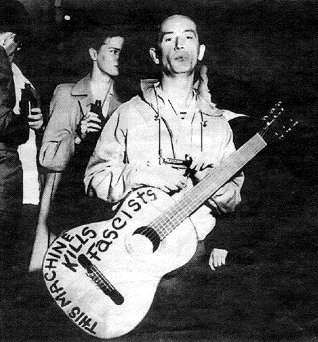 Steal this look: Inga Chernyak and Fred Benenson Steal this look: Inga Chernyak and Fred Benensonphoto: Brian Kennedy |
|
Over a cup of tea on Carmine Street, NYU junior Inga Chernyak explains how to break current copyright law. All it takes, Chernyak explains, is one finger on the Shift key while you put a CD in your computer, disabling corporate-installed software designed to prevent you from copying music. Just downloading a fairly purchased, DRM-protected CD from a laptop to an iPod amounts, in most cases, to a federal misdemeanor. "If I bought a CD that had DRM"—the software that blocks duplication—"I would obviate it," Chernyak says, carefully. "If there are laws I believe are wrong, I will break them." And she's just talking about Shift keys.
In fact, just explaining this maneuver may constitute aiding and abetting. "And for you to publish it!" Chernyak gasps. In response to cyberspace logistics, which create a copy each time a user takes a listen online, music industry corporate interests are bearing down hard on individual users, with a vast array of copyright protections on their side. It's a familiar story, and one that usually places the blame on "piracy," which supposedly robs artists of their due profits. But new ideas about the bounds of "fair use" are slowly shifting the blame to antiquated notions of intellectual property, for making copies a crime. Contrary to popular logic, there's an argument to be made that access to our common culture has never been as restricted as today, when the simple act of circulating a song comes with the threat of a lawsuit.
Chernyak and her friend Fred Benenson, a recent NYU graduate, make this argument at length, eyes widening. For them, the freedom to download music, as well as art in any medium, doesn't just mean sticking it to Sony: It's about maintaining a national tradition of grassroots cultural development. And if artists don't have access to our natural resources—if all digital copies are crimes—then that tradition, Chernyak says, is at risk. She and Benenson are the founders of Free Culture NYU, one chapter of what they predict will be the next great student movement. The man this time is RIAA, and Chernyak and Benenson are gearing up, cautiously, for a revolution.
Fittingly, they cribbed their arguments from the work of copyright lawyers— specifically, a popular 2004 nonfiction book called Free Culture by Lawrence Lessig. In the book, Lessig, a Stanford law professor, argues that piracy as we know it is just the latest development in technology distribution, and that this development makes it worth rethinking how we protect intellectual property. The American public shouldn't let corporations stifle our creative culture, he argues, simply because copyright legislation is working on outdated terms. Lessig says, in retrospect, that he never expected his book to inspire a student movement, but of course he's "thrilled." He had a hint, though, when he first came onto the campus scene in 2003 to help Free Culture's eventual founders, Swarthmore students Nelson Pavlosky and Luke Smith, take on Diebold, a voting-machine manufacturer. (Pavlosky and Smith had posted online some of the company's internal e-mails, and Diebold had responded by invoking copyright protections.) College campuses, Lessig notes, are natural incubators for Free Culture ideology. Today, a national network of chapters hosts websites, wikis, and blogs, as well as conventional meetings and protests. (The first regional Free Culture conference is scheduled for January 13 and 14 at Columbia.)
Despite some similarities, the movement hasn't lent itself easily to free-property ideology on the left, or free trade on the right. (This lack of partisan staging may be why Free Culture takes so much flack, from both sides, for not tackling more "important" problems.) Lessig remembers arriving at Swarthmore and finding "one self-acknowledged socialist," and "one self-acknowledged libertarian"; Chernyak proclaims herself a free-market radical, while Benenson broaches vague objections to American internationalism. What holds the group together is its consumer rights orientation: a broad and well-considered objection to the way copyright restrictions make most listeners and viewers into "passive consumers." Free Culture's mission is to convince students that the law, and not just their downloading habits, ought to work otherwise. "In a sense, we're a copyright reform organization," Chernyak explains. "What we aim to do is give direction to the way copyright reform is going to evolve."
At a recent meeting, Free Culture NYU, a dozen members strong, was exploding with responses to the latest in blogs. (Benenson says, "That in itself is tremendous, to have a weekly forum where you're talking about the cutting edge of copyright.") Then it was on to the group's best prospects for civil disobedience. Benenson, an aspiring digital artist, was advocating for a Free Culture–sponsored film-remixing contest: Tisch students would be presented with a feature film or two and, within a short time frame, encouraged to figure out what they can make of it.
As usual, the problem is copyright. Offer access to studio films too freely, and risk a lawsuit; then again, isn't risk, for these supposed rabble-rousers, just the point? An adult agitator who's been showing up lately—Trina Semorile, a former Ph.D. candidate at NYU's Steinhardt School of Education— keeps trying, clearly, to pull the group back to reality. Instead, what she's exposing is a generational gap. There are things worth being jailed for, she says—"a draft card," for example. It's the rhetoric of 20th-century activism. Benenson and Chernyak, however, are operating on different planes: not as part of a bottom-up, top-down struggle, but as a multi-dimensional network of players. Challenging copyright law isn't "about absolutes," Benenson tells Semorile. It's "about harm reduction": minimizing penalties and maximizing opportunities, for artists and audiences alike. More often than not, they have the same interests; they may even be the same people. And as the youth soccer league saying goes, when everyone plays, everyone wins.


